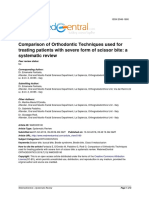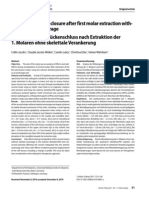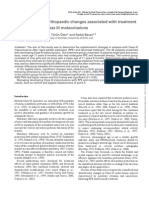New Ceph
New Ceph
Uploaded by
Obehi EromoseleCopyright:
Available Formats
New Ceph
New Ceph
Uploaded by
Obehi EromoseleOriginal Title
Copyright
Available Formats
Share this document
Did you find this document useful?
Is this content inappropriate?
Copyright:
Available Formats
New Ceph
New Ceph
Uploaded by
Obehi EromoseleCopyright:
Available Formats
DR OKOLI C.
N
OUTLINE
INTRODUCTION
TECHNIQUE
CEPHALOMETRIC LANDMARKS
METHODS OF ANALYSIS:
1. Classification of Analysis
2. Methods in detail
3. Digital cephalometry
ROLE IN ORTHODONTICS
CONCLUSION
REFERENCES
INTRODUCTION
Cephalometric radiographs were introduced in 1931 by
H. Hofrath and B.H. Broadbent who simultaneously
developed this very important tool.
It involves the study of dental and skeletal
relationships in the head encompassing the skull, face
and jaws. It may be lateral ,frontal or submentovertex.
It is standardized and reproducible.
Lateral cephalograph
Frontal cephalograph
Submentovertex cephalograph
TECHNIQUE
The radiograph is taken with a cephalostat which
encases the head. It has a nasofrontal guide (which
ensures the head is positioned correctly), two ear rods,
cassette holder and soft tissue filter.
The distance from the mid-saggital plane of the
patient to the X-ray source is 5feet (150cm), while the
distance from the same midline to the cassette holder
is 15cm.
PICTURE OF CEPHALOSTAT
PICTURE OF CEPHALOSTAT
TECHNIQUE
The analysis is done via tracing. The tracing is
produced from a cephalometric radiograph by digital
means or by copying outlines on paper. The manual
tracing is done with a lead pencil on the matte surface
of acetate paper, placed on a viewing box and best
done in a darkened room.
Templates can also be used in analysis.
TRACING OF CEPHALOMETRIC
RADIOGRAPH
CEPHALOMETRIC LANDMARKS
Landmarks are points serving as guides to
measurement. These points are joined together to form
planes. The following are important cephalometric
landmarks:
Nasion The junction of frontal and nasal bones in the
midline.
Sella The centre of the sella turcica.
Orbitale The lowest point on the rim of the orbit.
Porion- The highest point on the bony rim of the
external auditory meatus. There is an anatomic porion
and a machine porion.
CEPHALOMETRIC LANDMARKS
Anterior nasal spine- The
most anterior point on the
anterior nasal spine.
Posterior nasal spine- The tip
of the posterior spine of the
palatine bone.
A point- The deepest point on
the concave outline of the
maxilla.
B point- The deepest point on
the concave outline of the
mandible.
CEPHALOMETRIC LANDMARKS
Pogonion- The most anterior
point on the outline of the bony
chin.
Gnathion- The most anterior
inferior point on the bony chin.
Menton- The lowest point on the
outline of the bony chin.
Articulare- A point at the
intersection of the shadow of the
zygomatic arch and the posterior
border of the mandibular ramus.
CEPHALOMETRIC LANDMARKS
Basion- The lowest point on the
anterior rim of the foramen
magnum.
Bolton point- The highest point
on the upward curvature of the
retrocondylar fossa of the
occipital bone.
Gonion The intersection of
the lines tangent to the
posterior margin of the
ascending ramus and the
mandibular base.
Soft tissue glabella (G)- The
most prominent point on the soft
tissue drape of the
forehead.
Soft tissue menton (Me)- The most inferior point on
the soft tissue chin.
Soft tissue nasion (N)- The deepest point of the
concavity between the forehead and the nose.
Soft tissue pogonion (Pg, ) The most prominent
point on the soft tissue contour of the chin.
Soft tissue gnathion (Gn)
Pronasale- Tip of the nose
PLANES
S- N plane-Line that joins sella to nasion. Indicates anterior cranial
base.
Frankfort plane- Line that joins porion to orbitale.
Maxillary plane( Palatal plane)- ANS to PNS . Indicates orientation of
palate.
Occlusal plane- Drawn through the overlapping cusps of the molars
and premolars.
Mandibular plane- Joins the Gonion and Menton.
Nasion-perpendicular plane
E-line (esthetic line of Ricketts)
S-line(esthetic line of Steiners)
H-line (Harmony line of Holdaway)
Facial plane- Nasion to pogonion. Indicates the general orientation of
the facial profile.
COMMON ANGULAR
MEASUREMENT
SNA- The angle formed between the S-N plane and A
point.
SNB- The angle formed between the S-N plane and B point
FMA This provides a means of assessing the vertical
relation and the morphology of the lower third of the face.
High angle often associated with anterior open bite.
FMIA -Frankfort mandibular incisor angle
IMPA -Incisor mandibular plane angle
FACIAL HEIGHT Upper measured from N to ANS and
lower from ANS to Menton . Upper approx 45% of total
facial height.
S- N plane
Frankfort plane
Maxillary plane/
Palatal plane
Occlusal
plane
Mandibular
plane
METHODS OF ANALYSIS
The following are some methods:
o Downs
o Wylie
o Steiners
o Tweeds
o Sassouni
o Bjork-Jarabak
o Harvold
o Eastman
o Wits
o Ricketts
o McNamara
o Holdaway (soft tissue)
o Bass (aesthetic)
Cephalometric analysis may be:
Angular: (Down, McNamara, Tweeds, Rickets, Bjork,
Steiner)
Linear(Wits, Tweeds, Bjork, Harvold, Steiner)
Coordinates(Computerised cephalometrics);
Arcial (Sassouni analysis).
Methods in Detail
Downs Analysis:
Developed in 1948.
First published analysis.
He used the facial angle (angle formed at the
intersection of the Facial line and Frankfort plane) to
determine the degree of retrognathism,
orthognathism, prognathism .
TWEEDS ANALYSIS
Developed in 1948.
Used both linear and angular measurements.
Uses FMA, FMIA (Frankfort mandibular incisor
angle), IMPA (Incisor mandibular plane angle)
forming the Tweeds triangle.
Normal values FMA = 25
FMIA = 68
IMPA = 87
Tweeds triangle
RICKETTS ANALYSIS
First developed in 1960.
He developed a computerized analysis for routine use
by clinicians using a lateral and frontal cephalometric
tracing and a long range growth projection to maturity.
- This was to plan ahead for possible orthopaedic or
orthodontic interception or treatment.
- Its weakness was the use of unspecified samples, so
limited scientific validity.
Harvold Analysis
Developed in 1974.
This is concerned with the severity of jaw disharmony
using unit length of the maxilla and mandible. The
maxillary length is from the temporomandibular joint
to the ANS while the mandibular length is from the
same point to the bony chin.
The shorter the length of the vertical distance between
the maxilla and mandible, the more anteriorly placed
the chin is and vice versa.
Wits Analysis
Developed in 1975
Based on linear measurements and acts as an indicator for jaw
discrepancy.
Uses A and B points, as well as Occlusal plane, thus this
analytical method is dependent on dentition. Points A and B are
projected to the occlusal plane.
If A and B points intersect, the antero-posterior position is
normal.
If in Class II, point A is ahead of point B.
If in Class III, point B is ahead of point A.
The magnitude of the discrepancy is calculated from the
distance between these projections in millimetres.
Normal Wits values :
-1mm for men
0mm for women
McNamaras Analysis
First developed in 1983.
The antero-posterior position of the maxilla is
evaluated with regards to the nasion-perpendicular
line. The maxilla should be on, or slightly ahead of this
line.
The mandible is positioned in space using lower facial
height (ANS-menton).
SASSOUNIS ANALYSIS
Developed in 1955.
It was the first method to emphasize vertical as well as
horizontal relationships .
He noted that the following five planes converged at a
single point in a well-proportioned face.
Anterior cranial base
Frankfort plane
Occlusal plane
Maxillary plane
Mandibular plane
If the lines converged close to the face and diverged
quickly, the patient had a long face anteriorly and
short posteriorly , and was predisposed to a skeletal
open bite.
If the lines converged far behind in the face and
diverged slowly, the patient was predisposed to a
skeletal close bite.
Also, in a well-proportioned face, the ANS, maxillary
incisor and bony chin should be located along the
same arc.
Steiners Analysis
Developed by Cecil Steiner in 1950. First of the modern
cephalometric methods.
It emphasized individual measurements and their inter-
relationships.
SNA indicates the antero-posterior relationship of the maxilla
relative to the anterior cranial base.
SNB indicates the antero-posterior relationship of the mandible
relative to the anterior cranial base.
ANB is the difference between SNA and SNB. It indicates the
magnitude of the skeletal jaw discrepancy.
The relationship of the upper incisor to the Frankfort plane and
the lower incisor to the mandibular plane is also evaluated thus
establishing the relative protrusion of the dentition.
ANB of 2-4 :Skeletal pattern I
>4 : Skeletal pattern II
<2 : Skeletal pattern III
NIGERIAN VALUES CAUCASIAN VALUES
SNA 85.5
0
3.5
0
SNB - 82.7
0
3.0
0
ANB 2-4
0
1 to FP 119.0 127.0
0
1 to MP 96.0 104.0
0
1 to 1 108.0 -116.0
0
FMA 20.8
0
(24-26
0
)
SNA 82.2
0
2.0
0
SNB 78.0
0
2.0
0
ANB 2-4
0
1 to FP - 107.0
0
109.0
0
1 to MP 90.0
0
1 to 1 131.0-133.0
0
FMA 27.0
0
SNA >89 -prognathic maxilla, <82 retrognathic
maxilla
SNB>85.7-prognathic mandible ,<79.7-retrognathic
mandible
1 to FP>127 proclined upper incisors,<119-
retroclined incisors
1 to MP>1o4-proclined lower incisors, <96-
retroclined incisors
Wide interincisal angle-deep bite
FMA: high angle associated with anterior open bite
Digital Cephalometry
Standard films are replaced with a flat electronic pad. Digital
cephalometry reduces radiation exposure but still has good
image quality.
- Cephalometric data is analysed on a computer. The
landmarks on a radiograph or tracing are then converted
(digitization) to numerical values on a 2 or 3 dimensional
coordinate system. This allows for automatic measurement
of landmark relationships. Produces instant radiographic
images.
- Eliminates dark room facilities, development time and
expense.
- Disadvantages include cost, requirement for computer
training and security of the films.
Role in Orthodontics
DIAGNOSIS
Assessment of the patients dental and skeletal
relationships. For example, a patient with ANB of
>4 and I-FPA of 130 has a Skeletal pattern II and
proclined incisors.
Allows the nature of the problem to be analyzed
and precisely classified.
Role in Orthodontics
TREATMENT PLANNING
The planning of treatment by the clinician is better done
after considering the cephalogram to define
expected changes resulting from growth and
treatment and to plan appropriate treatment.
Analysis can tell the operator whether a certain
malocclusion is amenable to orthodontic treatment
or if orthognathic surgery will also be required
Role in Orthodontics
Monitoring orthodontic treatment progress.
Used to study changes brought about by
orthodontic treatment
Serial cephalometric radiographs taken at
intervals, before, during and after treatment can
be superimposed on reasonably stable areas to
study changes in jaw and tooth positions.
Role in Orthodontics
Prediction: Cephalometry may be used to estimate
growth changes that should occur for a patient
predicting future facial growth. This is helpful in
treatment planning.
It is also used to evaluate treatment outcome.
Role in Orthodontics
RESEARCH
Cephalometric radiographs are standard orthodontic
research tools used to evaluate skeletal structures, soft
tissues, angular and linear measurements of different
populations.
Role in Orthodontics
Soft tissue analysis
Assessment of the relationship of the soft tissue structures
to the skeletal elements as well as to the dentition. This can
be done using :
Holdaway line: A line tangent to the upper lip and chin.
Lower lip should be + or 1mm to this line.
Ricketts E-line: A line tangent to the nose and chin.
Assesses lip fullness.Lower lip should be 2mm in front of
this line , with the upper lip slightly behind.
Steiner S-line: A line joining the midpoint of the columella
to the soft tissue pogonion. The lips should fall on this line.
Role in Orthodontics
Steiner S-
line
Role in Orthodontics
It can be used to assess developmental changes
using the cervical vertebrae.
It can also be used to observe pathologic changes
in the skull, jaws, cranial base, and vertebrae.
It is important for record keeping, especially prior
to treatment.
For teaching purposes.
Medico legal uses.
CONCLUSION
Cephalometric analysis is an important tool in
orthodontics which enables the clinician to
appropriately manage malocclusion.
REFERENCES
Contemporary Orthodontics by Williams R. Proffit 4
TH
EDITION.
W and H Orthodontic Notes . Revised by Malcom L. Jones
and Richard G. Oliver 6
TH
EDITION.
Cephalometric Analysis as a tool for treatment planning
and evaluation. European Journal of Orthodontics 1981
Yan Gu , James A. McNamara Jnr, Cephalometric
Superimpositions, Angle Orthodontist Vol 78 No 6, 2008
Asad S. et al Assessment of antero-posterior of lips : E-line,
S-line, Pakistan Oral and Dental Journal Vol 31,No 1 (2011)
You might also like
- Bimaxillary ProtrusionDocument13 pagesBimaxillary ProtrusionMahdi ZakeriNo ratings yet
- Orthodontics and Dentofacial OrthopaedicsDocument18 pagesOrthodontics and Dentofacial OrthopaedicsSaniya Kulkarni100% (1)
- Wa600 6 PDFDocument1,675 pagesWa600 6 PDFWilliams Quispe67% (6)
- 1 The Case of The Missing Mona Lisa For Weebly ExampleDocument12 pages1 The Case of The Missing Mona Lisa For Weebly Exampleapi-298278157No ratings yet
- Fixed Orthodontic Appliances: A Practical GuideFrom EverandFixed Orthodontic Appliances: A Practical GuideRating: 1 out of 5 stars1/5 (1)
- Nanda Esthetics and Biomechanics 8.12.20Document15 pagesNanda Esthetics and Biomechanics 8.12.20Danial HassanNo ratings yet
- Post Traumatic Stress DisorderDocument2 pagesPost Traumatic Stress Disorderapi-188978784100% (1)
- Cephalometric AnalysisDocument57 pagesCephalometric Analysislatanya williams100% (1)
- Textbook of Orthodontics Samir Bishara 599 52MB 401 407Document7 pagesTextbook of Orthodontics Samir Bishara 599 52MB 401 407Ortodoncia UNAL 2020No ratings yet
- Orthodontics 2: Research Activity Part 3 of 3Document22 pagesOrthodontics 2: Research Activity Part 3 of 3Gem Hanna Callano ParaguaNo ratings yet
- Abo Clinical Exam Study GuideDocument15 pagesAbo Clinical Exam Study GuidealrowdhidentalNo ratings yet
- MorthDocument10 pagesMorthmohanad Al-shamiNo ratings yet
- Comparison of Orthodontic Techniques Used ForDocument5 pagesComparison of Orthodontic Techniques Used ForAdina SerbanNo ratings yet
- Rapid Maxillary Expansion and ApplianceDocument4 pagesRapid Maxillary Expansion and Appliancedrzana78No ratings yet
- Model AnalysisDocument58 pagesModel AnalysisHiba AbdullahNo ratings yet
- Management of Impacted Maxillary Canines Using Mandibular AnchorageDocument4 pagesManagement of Impacted Maxillary Canines Using Mandibular AnchorageplsssssNo ratings yet
- Orthodontic Space Closure After First Molar Extraction Without Skeletal AnchorageDocument10 pagesOrthodontic Space Closure After First Molar Extraction Without Skeletal AnchoragepatriciabdsNo ratings yet
- Face MaskDocument7 pagesFace MaskWaraphon JanewakornwongNo ratings yet
- Cranial Base Angle in Relation To MalocclusionDocument50 pagesCranial Base Angle in Relation To Malocclusionheycoolalex100% (1)
- Management of Impacted Canine: Anmol Goel Post Graduate Student Department of Orthodontics V.S Dental CollegeDocument193 pagesManagement of Impacted Canine: Anmol Goel Post Graduate Student Department of Orthodontics V.S Dental CollegeNeelima ChandranNo ratings yet
- Lecture 12&13 Myofunctional ApplianceDocument11 pagesLecture 12&13 Myofunctional ApplianceIbrahim HysamNo ratings yet
- Saliva / Orthodontic Courses by Indian Dental AcademyDocument191 pagesSaliva / Orthodontic Courses by Indian Dental Academyindian dental academyNo ratings yet
- Arch Expansion: Dr. Fatima Burney FCPS Part II ResidentDocument33 pagesArch Expansion: Dr. Fatima Burney FCPS Part II ResidentGareth BaleNo ratings yet
- Accelerated Orthodontics (AO) : The Past, Present and The FutureDocument11 pagesAccelerated Orthodontics (AO) : The Past, Present and The FuturesegurahNo ratings yet
- Theories of GrowthDocument137 pagesTheories of GrowthYuvashreeNo ratings yet
- Beta Angle 2003Document6 pagesBeta Angle 2003surendra334No ratings yet
- Written Examination GuideDocument17 pagesWritten Examination GuideIhsan HanbaliNo ratings yet
- CJM 037Document7 pagesCJM 037DrAshish KalawatNo ratings yet
- Evaluation of Soft-Tissue Changes in Young Adults Treated With The Forsus Fatigue-Resistant DeviceDocument11 pagesEvaluation of Soft-Tissue Changes in Young Adults Treated With The Forsus Fatigue-Resistant DeviceDominikaSkórkaNo ratings yet
- 2.assessment of Dental Crowding in Mandibular Anterior Region by Three Different MethodsDocument3 pages2.assessment of Dental Crowding in Mandibular Anterior Region by Three Different MethodsJennifer Abella Brown0% (1)
- TDocument2 pagesTNb100% (1)
- Orthodontic CurriculumDocument60 pagesOrthodontic CurriculumKiran Kumar100% (1)
- Impacted Canine: Presented By: Dr. Ahmed Shihab Supervised By: Dr. SarahDocument34 pagesImpacted Canine: Presented By: Dr. Ahmed Shihab Supervised By: Dr. SarahAhmed ShihabNo ratings yet
- Biomechanical Implications of Rotation Correction in Orthodontics - Case SeriesDocument5 pagesBiomechanical Implications of Rotation Correction in Orthodontics - Case SeriescempapiNo ratings yet
- Bimaxilary ProtrusionDocument7 pagesBimaxilary ProtrusionD YasIr MussaNo ratings yet
- Canine ImpactionDocument10 pagesCanine ImpactionPZ100% (1)
- Drugs in Orthodontics - 1Document43 pagesDrugs in Orthodontics - 1Sushma Rayal SANo ratings yet
- Manual of Dental Practice 2014 Estonia: Council of European DentistsDocument10 pagesManual of Dental Practice 2014 Estonia: Council of European DentistsMohd GhausNo ratings yet
- Index of Orthodontic Treatment NeedDocument3 pagesIndex of Orthodontic Treatment Needdaphne5khaw100% (2)
- 6-Errors in Cephalometrics PDFDocument27 pages6-Errors in Cephalometrics PDFHabeeb AL-AbsiNo ratings yet
- IBO QuestionsDocument3 pagesIBO QuestionsMariyamNo ratings yet
- The Ricketts Analysis Uses The Following MarkersDocument2 pagesThe Ricketts Analysis Uses The Following Markersmonwarul aziz100% (2)
- Burstone1962 PDFDocument18 pagesBurstone1962 PDFParameswaran ManiNo ratings yet
- Textbook of Orthodontics: Fig. 9.32HDocument7 pagesTextbook of Orthodontics: Fig. 9.32HNathalia AmeldaNo ratings yet
- Evaluation of Continuous Arch and Segmented Arch Leveling Techniques in Adult Patients-A Clinical Study PDFDocument6 pagesEvaluation of Continuous Arch and Segmented Arch Leveling Techniques in Adult Patients-A Clinical Study PDFDiana Paola FontechaNo ratings yet
- Orthodontics & Dentofacial Orthopaedics MDS - 403Document15 pagesOrthodontics & Dentofacial Orthopaedics MDS - 403RohanGarudNo ratings yet
- Par Index JurnalDocument10 pagesPar Index JurnalFaathir PutriNo ratings yet
- Orthognathic DR Shruthi PDFDocument54 pagesOrthognathic DR Shruthi PDFShruthee KNo ratings yet
- Extractions, Retention and Stability The Search For Orthodontic Truth Sheldon PeckDocument7 pagesExtractions, Retention and Stability The Search For Orthodontic Truth Sheldon PeckMonojit DuttaNo ratings yet
- Recent Advances in OrthodonticsDocument4 pagesRecent Advances in OrthodonticsInternational Journal of Innovative Science and Research TechnologyNo ratings yet
- Pendulum Appliance and Its Modifications 9752Document5 pagesPendulum Appliance and Its Modifications 9752dummyone2412No ratings yet
- 6 Postgraduate Notes in Orthodontics-250-299Document54 pages6 Postgraduate Notes in Orthodontics-250-299Mu'taz ArmanNo ratings yet
- Arch ExpansionDocument32 pagesArch ExpansionMoola Bharath Reddy100% (5)
- Anchorage: Nigel HarradineDocument20 pagesAnchorage: Nigel HarradineOsama Sayedahmed100% (1)
- Crossbite PosteriorDocument11 pagesCrossbite PosteriorrohmatuwidyaNo ratings yet
- Use of Laser Systems in OrthodonticsDocument8 pagesUse of Laser Systems in OrthodonticsCatherine NocuaNo ratings yet
- IZC OrthoDocument10 pagesIZC OrthoBashar A. HusseiniNo ratings yet
- Bracket PlaceDocument1 pageBracket PlaceamcsilvaNo ratings yet
- Diagnosis and Treatment PlanningDocument93 pagesDiagnosis and Treatment PlanningVikkii VeerakumarNo ratings yet
- Sassouni AnalisisDocument2 pagesSassouni Analisisナスティオン ファジャルNo ratings yet
- Seminars in OrthodonticsDocument3 pagesSeminars in Orthodonticsgriffone1No ratings yet
- Relationship of Parental Knowledge and Attitude With Oral Health Status of Children in Karachi EastDocument9 pagesRelationship of Parental Knowledge and Attitude With Oral Health Status of Children in Karachi EastpriskayoviNo ratings yet
- Evaluation of Temporomandibular Joint Spaces and Condylar Position - A CBCT StudyDocument6 pagesEvaluation of Temporomandibular Joint Spaces and Condylar Position - A CBCT StudyDr Yamuna Rani100% (1)
- Aro Village SystemDocument5 pagesAro Village SystemObehi EromoseleNo ratings yet
- Wound and Wound HealingDocument28 pagesWound and Wound HealingObehi Eromosele0% (1)
- Beyond Beading BasicsDocument146 pagesBeyond Beading BasicsTestera Aretset100% (3)
- Pathfinder Pei Nov2011Document111 pagesPathfinder Pei Nov2011Obehi EromoseleNo ratings yet
- Pathfinder Pei Nov2011Document111 pagesPathfinder Pei Nov2011Obehi EromoseleNo ratings yet
- 20 Catalogue 2012Document33 pages20 Catalogue 2012Obehi EromoseleNo ratings yet
- CDC Guideline For Infection Control - Rr5217Document76 pagesCDC Guideline For Infection Control - Rr5217stajziehchiNo ratings yet
- Examination of Head and Neck SwellingsDocument22 pagesExamination of Head and Neck SwellingsObehi EromoseleNo ratings yet
- Constructivism Paradigm of TheoriesDocument32 pagesConstructivism Paradigm of Theoriesman_dainese100% (1)
- 1.2.2.3 Lab - Explore Sources of Open DataDocument17 pages1.2.2.3 Lab - Explore Sources of Open Dataabdulaziz doroNo ratings yet
- Suit For Specific Performance of Contract To Sell A Residential PlotDocument3 pagesSuit For Specific Performance of Contract To Sell A Residential PlotAAKANKSHA BHATIA100% (2)
- The Hero's Journey - Lord of The Rings: The Fellowship of The RingDocument1 pageThe Hero's Journey - Lord of The Rings: The Fellowship of The RingjanaNo ratings yet
- New Version Physics of BikesDocument6 pagesNew Version Physics of Bikesapi-239483431No ratings yet
- Physics Standard Level Paper 3: Instructions To CandidatesDocument24 pagesPhysics Standard Level Paper 3: Instructions To CandidatesHADRIANNo ratings yet
- 162 - Aguirre V FQBDocument2 pages162 - Aguirre V FQBColee StiflerNo ratings yet
- Hardy AnthologyDocument47 pagesHardy Anthologysarahaliceparker100% (1)
- Case Study - Pantaloon RetailDocument8 pagesCase Study - Pantaloon Retailkratika_usms100% (1)
- COVID Home Care PDF FinalDocument1 pageCOVID Home Care PDF FinalvimalsunNo ratings yet
- Intro To P3M3Document67 pagesIntro To P3M3Ary EppelNo ratings yet
- CBSE Class 7 Maths WorksheetDocument3 pagesCBSE Class 7 Maths WorksheetRamkrishna64% (11)
- Rizal Memorial Colleges IncDocument5 pagesRizal Memorial Colleges IncAlgie Rose Otero TolentinoNo ratings yet
- People V KalaloDocument2 pagesPeople V KalaloPrincessAngelaDeLeon100% (1)
- 2.orbital Aspects of Satellite CommunicationsDocument65 pages2.orbital Aspects of Satellite Communicationsمحمود عبدالرحمن ابراهيمNo ratings yet
- Right To Strike Under Industrial Dispute Act, 1947: Brief OverviewDocument11 pagesRight To Strike Under Industrial Dispute Act, 1947: Brief OverviewYash ChoudharyNo ratings yet
- Course OutlineDocument3 pagesCourse OutlineHajiasifAliNo ratings yet
- Development and Validation of Food Frequency Quest PDFDocument8 pagesDevelopment and Validation of Food Frequency Quest PDFeva dwiNo ratings yet
- SOAL MID Semester Ganjil 2015-2016Document3 pagesSOAL MID Semester Ganjil 2015-2016Rahmat NurudinNo ratings yet
- ProspectusDocument246 pagesProspectusTushar GuptaNo ratings yet
- Lean AccountingDocument16 pagesLean AccountingJonas LeoNo ratings yet
- Applied Ethics - Fa3-Fa8 & Sa1-Sa2Document8 pagesApplied Ethics - Fa3-Fa8 & Sa1-Sa2Steph GonzagaNo ratings yet
- Factors Necessary For Appropriate Service StandardDocument2 pagesFactors Necessary For Appropriate Service StandardHarsha July100% (1)
- General Truths, Laws of Nature, Things Which Are Always TrueDocument6 pagesGeneral Truths, Laws of Nature, Things Which Are Always TrueDaniela InczeNo ratings yet
- Contributions of Americans To The PhilippinesDocument12 pagesContributions of Americans To The PhilippinesDennissa Rose Pormon67% (3)
- Progress Test 2BDocument2 pagesProgress Test 2BZuzia MatyjaNo ratings yet
- Seminar 2 Natural DisasterDocument2 pagesSeminar 2 Natural Disasteroonooo0702No ratings yet
































































































